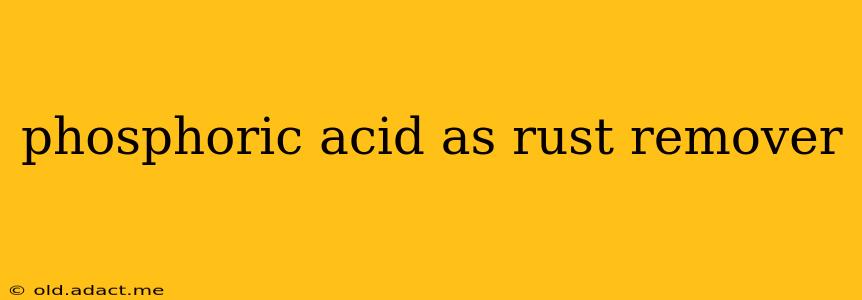Phosphoric acid is a powerful and effective rust remover, widely used by both professionals and DIY enthusiasts. Its effectiveness stems from its ability to chemically react with iron oxide (rust), converting it into a water-soluble compound that can be easily rinsed away. This guide will delve into the intricacies of using phosphoric acid for rust removal, addressing common questions and concerns.
What is Phosphoric Acid?
Phosphoric acid (H₃PO₄) is a weak, non-toxic acid commonly found in various household products, including some cola drinks and cleaning solutions. Its relatively low toxicity compared to other strong acids makes it a safer option for rust removal, although appropriate safety precautions should always be taken. In its pure form, it’s a colorless, odorless, syrupy liquid.
How Does Phosphoric Acid Remove Rust?
Phosphoric acid works by chemically converting iron oxide (Fe₂O₃), the main component of rust, into iron phosphate (FePO₄). This conversion process is known as chelation. Iron phosphate is a stable, water-soluble compound that can be easily washed away, leaving behind a clean, rust-free surface. The reaction also creates a protective layer of iron phosphate, which can help prevent future rust formation. This is why phosphoric acid is often included in rust preventative treatments.
Is Phosphoric Acid Safe to Use?
While phosphoric acid is relatively less hazardous than many other strong acids, it's crucial to handle it with care. Always wear appropriate safety gear, including gloves, eye protection, and a respirator to prevent inhalation of fumes. Work in a well-ventilated area and avoid skin contact. If contact occurs, immediately rinse the affected area with plenty of water. Always follow the manufacturer's instructions on the product label.
What are the Different Forms of Phosphoric Acid Rust Removers?
Phosphoric acid is available in several forms:
- Liquid Concentrates: These require dilution with water before use, allowing for customizable strength based on the rust's severity.
- Pre-mixed Solutions: These are ready-to-use and convenient but offer less control over concentration.
- Gel Formulations: These are ideal for vertical surfaces, as they adhere better and prevent dripping.
How to Use Phosphoric Acid to Remove Rust?
The application method depends on the form of the phosphoric acid and the extent of rust. Generally, the process involves:
- Preparation: Clean the rusted surface to remove loose rust and debris.
- Application: Apply the phosphoric acid solution using a brush, sponge, or spray bottle, ensuring complete coverage of the rusted area.
- Reaction Time: Allow the solution to react with the rust for the recommended time (usually 15-30 minutes, but check the product instructions).
- Scrubbing: Gently scrub the surface with a wire brush or scouring pad to remove loosened rust.
- Rinsing: Thoroughly rinse the surface with clean water to remove all traces of phosphoric acid.
- Drying: Allow the surface to dry completely.
What are the Advantages of Using Phosphoric Acid for Rust Removal?
- Effectiveness: Phosphoric acid effectively removes rust without damaging the underlying metal.
- Relatively Safe: Compared to other strong acids, phosphoric acid poses a lower risk.
- Protective Layer: It forms a protective phosphate layer, inhibiting further rust formation.
- Readily Available: Phosphoric acid rust removers are widely available at hardware stores and online retailers.
What are the Disadvantages of Using Phosphoric Acid for Rust Removal?
- Potential for Skin Irritation: Direct contact can cause skin irritation, hence the need for safety gear.
- Fumes: Inhaling the fumes can be irritating to the respiratory system.
- Not Suitable for All Metals: It may react negatively with certain metals, so it's crucial to test in an inconspicuous area first.
Can Phosphoric Acid Remove Rust from Aluminum?
No, phosphoric acid is not recommended for use on aluminum. It can react with aluminum, leading to damage and discoloration.
Can I Use Phosphoric Acid on Car Parts?
While phosphoric acid can be used on some car parts, it's crucial to test it on an inconspicuous area first. Always follow the manufacturer's instructions carefully. Some car parts may require more specialized rust removal treatments.
What are Some Alternatives to Phosphoric Acid Rust Remover?
Other rust removal methods include mechanical methods (wire brushing, sanding), electrolytic rust removal, and the use of oxalic acid or citric acid. However, phosphoric acid is generally considered one of the most effective and relatively safe chemical options.
This guide provides a comprehensive overview of using phosphoric acid as a rust remover. Remember always to prioritize safety and follow the manufacturer’s instructions for optimal results. Always test on an inconspicuous area first, especially if working with valuable or sensitive items.
